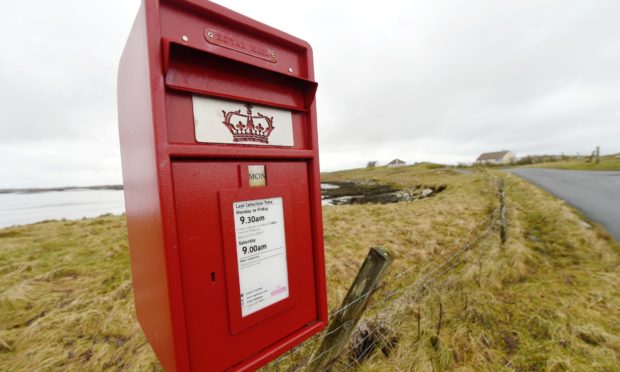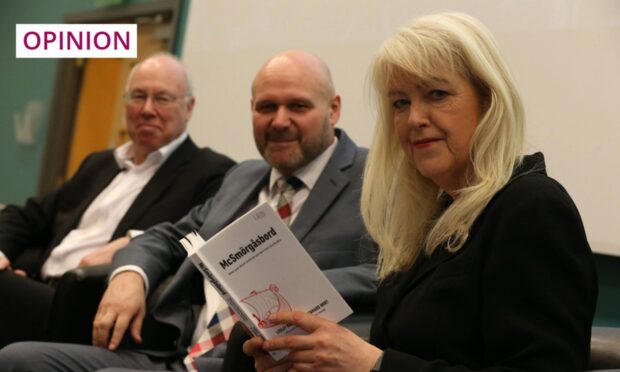The Post Office and the Royal Mail are two of the nation’s great social institutions.
MacBrayne’s (now CalMac) is another as, I think, was Grampian Television when I worked for them in the good old days when it was run by local loons made good.
Something is lost when the local becomes the global and when decisions that used to be made on the pier head are removed to some central office far away, or when the local bank manager exists no more and your mortgage or overdraft are dealt with by a remote call centre or machine.
Maybe, after all, Captain MacKinnon knew when it was safe to sail the Minch, and perhaps bank manager Angus knew who could borrow and was likely to repay more than online.com now knows.
Colours matters too. For good or ill, those of us who grew up under the lordship of MacBrayne’s will not forget their red and black funnels and their equally colourful buses.
And of course, the red post van and the red letter box and the red telephone box gave a bright and hugely distinctive look to both the Post Office and the Royal Mail. Postman Pat – or Pàdraig Post as he’s known around here – was no fiction.
I love the language of colours, and remember hearing about Flemish customs in which the colour of the notepaper you used sent a clear signal. If a girl wrote to a boy on blue paper it signified “I should like to love you”. If on pink, “I love you dearly”, green “I hope you will love me”, violet “You love me in secret” and yellow “I do not love you”. So be careful what paper you write on to your Flemish lovers.
I think post persons (is that the right terminology?) in cities still walk their delivery patches, though the brogues and the bike have given way to the van in most rural areas. I’m old enough to remember the walking and cycling postman. In my native South Uist the district postman was Iain MacIsaac, known as the “Saighdear” (soldier) whose delivery territory varied according to the folk he met on their way to the pub!
And then there was Archie Kennedy on the island of Seil who cycled his way round the island with his saddle on his back. He whistled as he delivered the mail, for whistling is one of the joys of working outside. A good march, strathspey and reel pipe tune is best, for there is nothing grander on a fine summer’s morning than the postie arriving with an airmail letter while whistling the two-four march Father John MacMillan of Barra.
Though a friend told me the other day that whistling is also a bit of a code-breaker – his mum always knew when his dad was thinking of secretly heading off to the pub because he then started whistling without realising it!
I know that posting letters and parcels is, and always has been, big business. I also delight in the fact that it was an Arbroath laddie, Thomas Chalmers, who invented the sticky-on stamp.
OK, there is some dispute over that but his name still stands strong as the man in the 1830s who fought for the principle of the penny post – that all-important principle that, whether you are sending a letter from John o’ Groats to Land’s End or from St John’s Wood to Lambeth within London itself, it should still cost the same.
It’s the lovely principle of universality that has served us well despite privatisation and unfair island surcharges.
And I think the ritual of sending and receiving letters is important. Despite our daily reliance on email and the internet, and despite the fact that most of the letters we receive might be junk mail, there’s still nothing like a lovely hand-written envelope coming to you through the post. It’s a thing to savour.
I always enjoyed Slaughterhouse Five author Kurt Vonnegut’s ritual when posting letters. He would write the letter, then go down to the post office, stand in the queue and chat to whoever was there, buy a stamp, lick it on to the envelope and then put it in the letter box.
One letter at a time, even though his wife pleaded with him to buy a pack of envelopes and a book of stamps, obviously saving him the need to go down to the post office day after day to buy that single envelope and single stamp. Quite rightly he said to her: “But that would take all the fun out of it.”
So go on. This week sit down and take out a sheet of paper. Basildon Bond is best. And find a pen – remember what that is? A fountain pen preferably. And write to a friend you haven’t written to in ages. Then off to the post office with you, whistling, to buy a single envelope and a sticky stamp and chat to whoever is there.
Just imagine the joy of the friend who will receive that letter, and the delight of the postie delivering something lovely, for a change.
Angus Peter Campbell is an award-winning writer and actor from Uist











